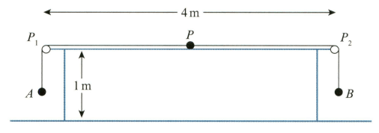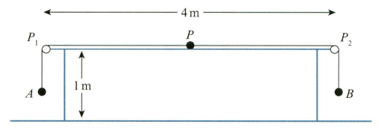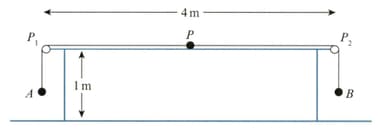Particles and of masses and respectively, are joined by a light inextensible string that passes over a small, smooth, fixed pulley. The particles are held at rest with the string taut and its straight parts vertical. Initially, both particles are above the ground and below the pulley. The system is released from rest.
Find the speed of and reaches the pulley. The string then breaks and falls to the ground. Find the time from when the system is released to when hits the ground.

Important Questions on Connected Particles
Particles and each of mass are attached to the ends of a light inextensible string. Particle is held on a smooth slope inclined at to the horizontal. The string passes over a small smooth pulley at the top of the slope and particle hangs vertically below the pulley. Particle is released and moves up the slope.Particle hits the ground after It then stays on the ground and particle travels further up the slope. Particle A does not reach the pulley in the subsequent motion.
Find the acceleration of particle up the slope.
Particles and each of mass are attached to the ends of a light inextensible string. Particle is held on a smooth slope inclined at to the horizontal. The string passes over a small smooth pulley at the top of the slope and particle hangs vertically below the pulley. Particle is released and moves up the slope.Particle hits the ground after It then stays on the ground and the particle travels further up the slope. Particle does not reach the pulley in the subsequent motion.
Find the distance travelled by particle from when it is released to when it comes to instantaneous rest.
Particles and of masses and respectively, are attached to the ends of a light inextensible string. Particle is held on a rough horizontal surface with coefficient of friction The string passes over a small smooth pulley at the edge of the surface, at a distance from particle Particle hangs vertically below the pulley. Particle is released and particle descends to reach the ground. When particle reaches the ground, it stays there. Find the time taken from the start until particle comes to instantaneous rest.
A crate of mass is pulled vertically upwards using a rope that passes over a first pulley, under a second pulley and over a third pulley. At the other end of the rope there is a ball of mass Each pulley has mass The first and third pulleys are fixed at the same horizontal level and are apart. The second pulley is an equal distance from the first and third pulleys and hangs at a distance below them. It is not fixed, but it does not move.
What modelling assumptions need to be made? Which of these assumptions is unlikely to affect the equilibrium of the second pulley?
A crate of mass is pulled vertically upwards using a rope that passes over a first pulley, under a second pulley and over a third pulley. At the other end of the rope there is a ball of mass Each pulley has mass The first and third pulleys are fixed at the same horizontal level and are apart. The second pulley is an equal distance from the first and third pulleys and hangs at a distance below them. It is not fixed, but it does not move.
Find the value of

A light inextensible string of length has particles and of masses and respectively, attached to its ends. Another particle, of mass is attached to the mid-point of the string. Two small smooth pulleys and are fixed at opposite ends of a rough horizontal table of length and height The string passes over and with particle held at rest vertically below the string taut and hanging freely below Particle is in contact with the table halfway between and (see diagram). The coefficient of friction between and the table is Particle is released and the system starts to move with constant acceleration of magnitude The tension in the part of the string is and the tension in the part of the string is
Find and in terms of

A light inextensible string of length has particles and of masses and respectively, attached to its ends. Another particle, of mass is attached to the mid-point of the string. Two small smooth pulleys and are fixed at opposite ends of a rough horizontal table of length and height The string passes over and with particle held at rest vertically below the string taut and hanging freely below Particle is in contact with the table halfway between and (see diagram). The coefficient of friction between and the table is Particle is released and the system starts to move with constant acceleration of magnitude The tension in the part of the string is and the tension in the part of the string is
Show, by considering the motion of that

A light inextensible string of length has particles and of masses and respectively, attached to its ends. Another particle, of mass is attached to the mid-point of the string. Two small smooth pulleys and are fixed at opposite ends of a rough horizontal table of length and height The string passes over and with particle held at rest vertically below the string taut and hanging freely below Particle is in contact with the table halfway between and (see diagram). The coefficient of friction between and the table is Particle is released and the system starts to move with constant acceleration of magnitude The tension in the part of the string is and the tension in the part of the string is
Find the speed of the particles immediately before reaches the floor.
